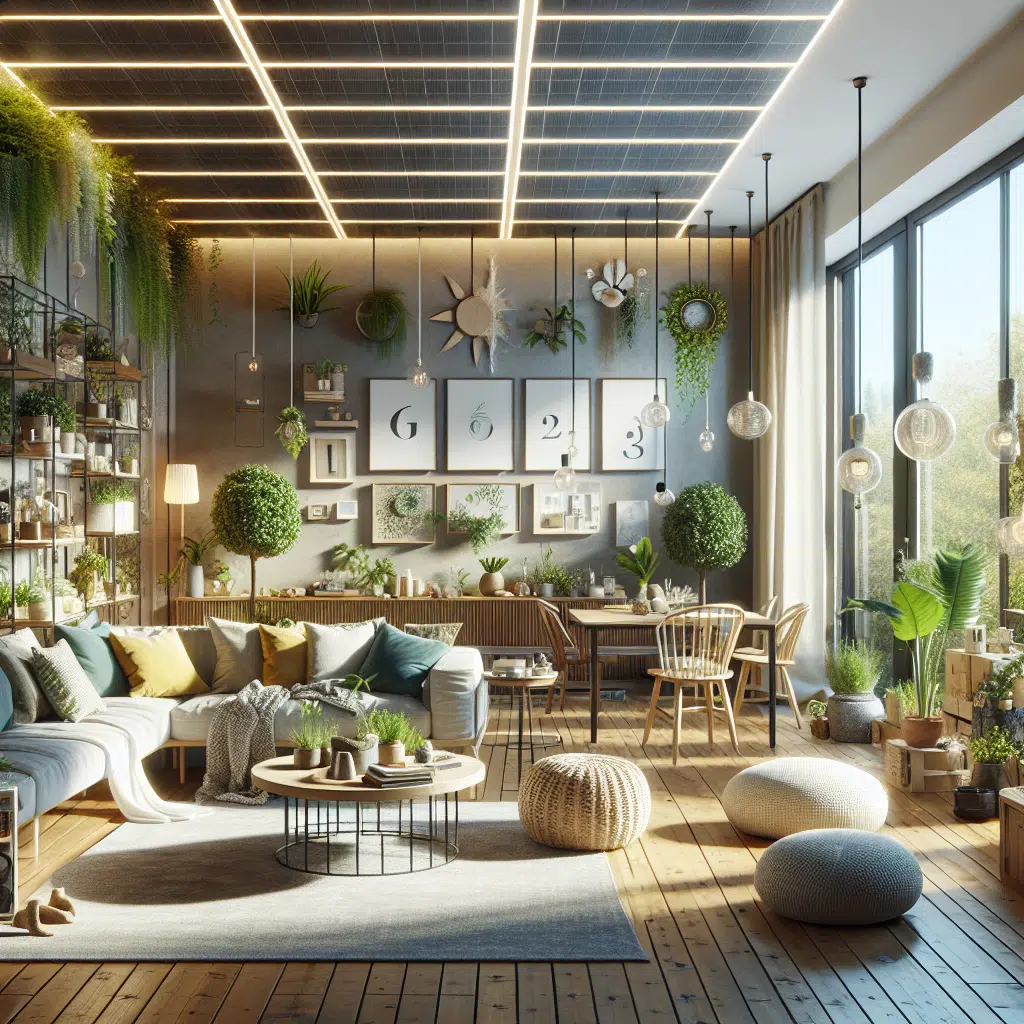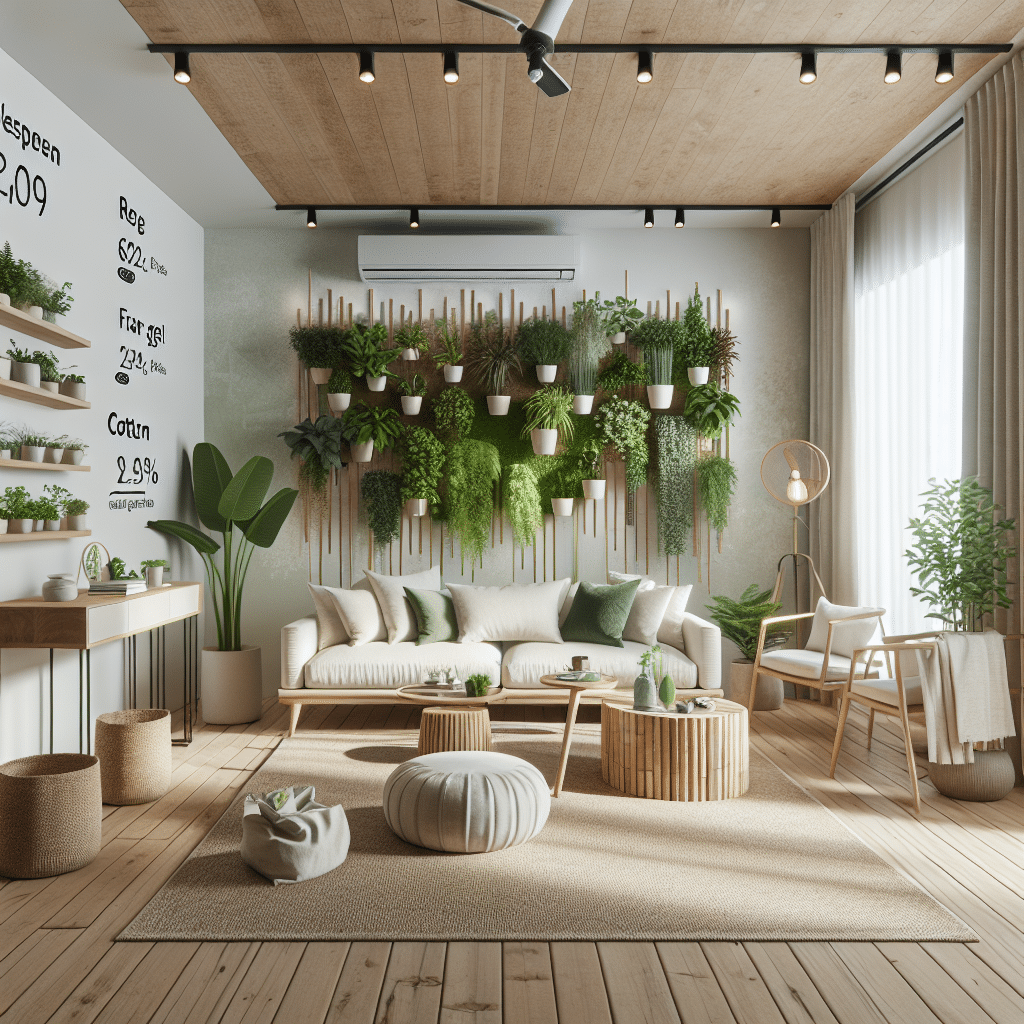
: Home » Blog » Rustic Decor » Embrace Eco-Friendly Decor: The New Trend in Home Design
When it comes to home design, more and more people are embracing the idea of Eco-Friendly Decor. Sustainable materials are becoming increasingly popular as homeowners seek to reduce their environmental impact and create a healthier living space. In this article, we will explore some of the sustainable materials that can be used for Eco-Friendly Decor.
One of the most commonly used sustainable materials in home design is bamboo. Bamboo is a fast-growing grass that can be harvested without killing the plant, making it a highly renewable resource. It is also incredibly versatile and can be used for a wide range of applications, from flooring to furniture. Bamboo flooring, in particular, has gained popularity in recent years due to its durability and natural beauty.
Another sustainable material that is gaining traction in the world of Eco-Friendly Decor is reclaimed wood. Reclaimed wood is salvaged from old buildings, barns, and other structures that are no longer in use. By repurposing this wood, homeowners can give it a new life and prevent it from ending up in a landfill. Reclaimed wood has a unique character and warmth that cannot be replicated with new materials, making it a popular choice for flooring, furniture, and accent pieces.
Cork is another sustainable material that is often used in Eco-Friendly Decor. Cork is harvested from the bark of cork oak trees, which can be harvested without harming the tree. This makes cork a highly renewable resource. Cork flooring is not only eco-friendly but also has many practical benefits. It is naturally resistant to mold, mildew, and pests, making it a great choice for kitchens and bathrooms. Additionally, cork has natural sound-absorbing properties, making it an excellent option for reducing noise in a home.
For those looking to add a touch of luxury to their Eco-Friendly Decor, there are sustainable options available as well. For example, organic cotton is a popular choice for bedding and upholstery. Organic cotton is grown without the use of harmful pesticides and chemicals, making it better for both the environment and your health. Similarly, hemp fabric is another sustainable option that is gaining popularity. Hemp is a fast-growing plant that requires little water and no pesticides to grow, making it an excellent choice for eco-friendly textiles.
In addition to these materials, there are many other sustainable options available for Eco-Friendly Decor. For example, recycled glass can be used for countertops, tiles, and decorative accents. It is made from post-consumer glass that would otherwise end up in a landfill. Recycled glass has a unique beauty and can add a pop of color to any space.
In conclusion, sustainable materials are a key component of Eco-Friendly Decor. Bamboo, reclaimed wood, cork, organic cotton, hemp fabric, and recycled glass are just a few examples of the many sustainable options available. By incorporating these materials into our homes, we can create a more environmentally friendly and healthier living space. So why not join the trend and embrace Eco-Friendly Decor in your own home?
Incorporating Natural Elements in Eco-Friendly Home Design
When it comes to home design, more and more people are embracing the idea of going green. Eco-Friendly Decor is a new trend that not only helps the environment but also creates a peaceful and harmonious living space. One way to achieve this is by incorporating natural elements into your home design.
One of the easiest ways to bring nature indoors is by using plants. Not only do they add a touch of greenery to your space, but they also help purify the air. Plants like spider plants, peace lilies, and snake plants are known for their air-purifying properties. They can remove toxins from the air and create a healthier living environment for you and your family.
Another way to incorporate natural elements is by using sustainable materials in your home design. Instead of using traditional hardwood flooring, consider using bamboo or cork. These materials are not only eco-friendly but also durable and stylish. Bamboo, in particular, is a fast-growing grass that can be harvested without killing the plant, making it a sustainable choice.
When it comes to furniture, opt for pieces made from reclaimed or recycled materials. This not only reduces waste but also adds a unique and rustic touch to your home. Look for furniture made from reclaimed wood or recycled metal. These materials have a story to tell and can add character to your space.
In addition to using sustainable materials, consider incorporating natural textures into your home design. Use natural fibers like jute, hemp, or organic cotton for your rugs, curtains, and upholstery. These materials not only add warmth and texture to your space but also have a lower environmental impact compared to synthetic materials.
Lighting is another important aspect of eco-friendly home design. Instead of using traditional incandescent bulbs, switch to energy-efficient LED lights. LED lights consume less energy and last longer, reducing your carbon footprint and saving you money on your energy bills. You can also maximize natural light by using sheer curtains or installing skylights to brighten up your space.
When it comes to color schemes, opt for earthy tones and natural hues. Colors like greens, browns, and blues can create a calming and soothing atmosphere. Avoid using harsh and synthetic colors that can be overwhelming and create a sense of artificiality. By using natural colors, you can create a space that feels connected to the outdoors and promotes a sense of tranquility.
Lastly, don’t forget to bring in natural elements through artwork and accessories. Hang nature-inspired paintings or photographs on your walls. Display seashells, rocks, or driftwood as decorative pieces. These small touches can add a sense of serenity and remind you of the beauty of the natural world.
Incorporating natural elements in your home design not only helps the environment but also creates a space that promotes well-being and relaxation. By using plants, sustainable materials, natural textures, energy-efficient lighting, earthy colors, and nature-inspired artwork, you can create an eco-friendly and aesthetically pleasing living space. So why not embrace the trend of Eco-Friendly Decor and bring a touch of nature into your home?

Eco-Friendly Decor: A New Trend in Home Design
When it comes to home design, more and more people are embracing the idea of Eco-Friendly Decor. Not only does it help reduce our carbon footprint, but it also adds a touch of style to any space. One area where eco-friendly options are gaining popularity is lighting. In this section, we will explore some of the best eco-friendly lighting options for stylish decor.
LED lights are a fantastic choice for those looking to incorporate eco-friendly lighting into their home. Not only do they use significantly less energy than traditional incandescent bulbs, but they also last much longer. LED lights are available in a variety of styles and colors, making it easy to find the perfect fit for any room. Whether you prefer a warm, soft glow or a bright, white light, LED lights can provide the ambiance you desire while being energy-efficient.
Another eco-friendly lighting option to consider is compact fluorescent lamps (CFLs). These bulbs use about 75% less energy than incandescent bulbs and can last up to ten times longer. CFLs are available in a range of shapes and sizes, making them suitable for any lighting fixture. They may take a few moments to reach their full brightness, but once they do, they provide a warm and inviting glow.
If you’re looking for a more unique and artistic lighting option, consider using solar-powered lights. These lights harness the power of the sun to provide illumination, making them an excellent choice for outdoor spaces. Solar-powered lights come in various designs, from string lights to lanterns, allowing you to create a magical atmosphere in your garden or patio. Plus, they are completely energy-efficient and require no additional electricity.
For those who prefer a more natural and rustic look, bamboo lighting is an excellent choice. Bamboo is a sustainable material that grows quickly and can be harvested without causing harm to the environment. Bamboo lights come in various shapes and sizes, from pendant lights to floor lamps, and add a touch of warmth and elegance to any space. They are not only eco-friendly but also incredibly stylish.
If you’re looking to make a statement with your lighting, reclaimed wood fixtures are a great option. These fixtures are made from salvaged wood, giving them a unique and rustic charm. Reclaimed wood lights come in various styles, from chandeliers to table lamps, and can add a touch of character to any room. By using reclaimed materials, you are not only reducing waste but also creating a one-of-a-kind piece for your home.
In conclusion, eco-friendly lighting options are a fantastic way to incorporate sustainability into your home decor. LED lights, CFLs, solar-powered lights, bamboo lighting, and reclaimed wood fixtures are all excellent choices for those looking to create a stylish and environmentally-friendly space. By choosing these options, you can reduce your energy consumption and make a positive impact on the planet, all while adding a touch of elegance to your home. So why not embrace the Eco-Friendly Decor trend and light up your space in style?
Creating a Minimalist and Eco-Friendly Living Space
In recent years, there has been a growing trend towards creating minimalist and eco-friendly living spaces. People are becoming more conscious of the impact their choices have on the environment and are seeking ways to reduce their carbon footprint. One way to do this is by incorporating Eco-Friendly Decor into their homes.
When it comes to creating a minimalist and eco-friendly living space, the key is to focus on simplicity and sustainability. This means choosing furniture and accessories that are made from natural and renewable materials, such as bamboo, reclaimed wood, or organic cotton. These materials not only have a lower environmental impact but also add a touch of warmth and natural beauty to any room.
Another important aspect of creating an eco-friendly living space is to minimize waste. This can be achieved by opting for furniture and decor pieces that are multifunctional and have a long lifespan. For example, a coffee table that doubles as a storage unit or a sofa that can be transformed into a bed. By choosing versatile pieces, you can reduce the need for additional furniture and ultimately reduce waste.
In addition to choosing sustainable materials and minimizing waste, it is also important to consider the energy efficiency of your home. This can be achieved by investing in energy-efficient appliances, such as LED light bulbs, smart thermostats, and low-flow showerheads. These small changes can make a big difference in reducing your energy consumption and lowering your utility bills.
When it comes to color schemes, opting for neutral tones can help create a minimalist and calming atmosphere. Whites, grays, and earthy tones not only create a sense of serenity but also allow for easy coordination with different decor styles. By keeping the color palette simple, you can create a timeless and versatile space that can easily be updated with small changes in accessories or artwork.
In terms of decor, incorporating plants into your living space is a great way to add a touch of nature and improve air quality. Plants not only provide oxygen but also help to filter out toxins from the air. Choose low-maintenance plants, such as succulents or snake plants, that require minimal watering and care. Not only will they add a pop of green to your space, but they will also contribute to a healthier and more eco-friendly environment.
When it comes to storage, opting for open shelving or minimalistic storage solutions can help create a clutter-free and organized space. By keeping your belongings visible and easily accessible, you can avoid unnecessary purchases and reduce the accumulation of unnecessary items. This not only helps to create a minimalist aesthetic but also promotes a more sustainable lifestyle.
In conclusion, creating a minimalist and eco-friendly living space is all about simplicity, sustainability, and conscious choices. By choosing furniture and decor made from natural and renewable materials, minimizing waste, and considering energy efficiency, you can create a space that is not only aesthetically pleasing but also environmentally friendly. Incorporating plants, opting for neutral color schemes, and embracing minimalistic storage solutions are additional ways to enhance the eco-friendly atmosphere of your home. So why not join the trend and create a living space that is not only beautiful but also kind to the planet?
Eco-Friendly Decor: A New Trend in Home Design
In recent years, there has been a growing trend towards eco-friendly home decor. People are becoming more conscious of the impact their choices have on the environment and are seeking ways to reduce waste and live more sustainably. One popular aspect of this trend is upcycling and repurposing, which involves giving new life to old items and materials.
Upcycling is the process of transforming discarded or unused objects into something of higher value or quality. It’s a creative way to breathe new life into old items that would otherwise end up in landfills. Repurposing, on the other hand, involves finding alternative uses for items that may have outlived their original purpose. Both practices are not only environmentally friendly but also offer a unique and personalized touch to home decor.
One of the most common items that people upcycle or repurpose is furniture. Instead of buying new pieces, many homeowners are opting to refurbish old chairs, tables, and cabinets. With a fresh coat of paint or new upholstery, these items can be transformed into stunning focal points in any room. Not only does this save money, but it also reduces the demand for new furniture production, which often involves the use of harmful chemicals and contributes to deforestation.
Another popular way to incorporate upcycling and repurposing into home decor is through the use of reclaimed materials. Salvaged wood, for example, can be used to create unique and rustic furniture pieces. Old doors can be turned into headboards, and discarded pallets can be transformed into stylish coffee tables. By giving these materials a second life, homeowners can add character and charm to their spaces while reducing the need for new resource extraction.
In addition to furniture, upcycling and repurposing can be applied to various other aspects of home decor. For instance, old mason jars can be turned into trendy light fixtures, and wine bottles can be transformed into decorative vases. By thinking outside the box and getting creative, homeowners can find countless ways to repurpose everyday items and reduce waste.
Not only does upcycling and repurposing contribute to a more sustainable lifestyle, but it also allows homeowners to express their individuality and personal style. Each upcycled or repurposed item is unique and tells a story. It adds a touch of personality to a space that cannot be achieved with mass-produced, store-bought items. Plus, the satisfaction of creating something beautiful and functional out of what was once considered trash is truly rewarding.
In conclusion, upcycling and repurposing have become a significant part of the eco-friendly home decor trend. By giving new life to old items and materials, homeowners can reduce waste, save money, and add a personal touch to their spaces. Whether it’s refurbishing furniture, using reclaimed materials, or repurposing everyday items, there are countless ways to incorporate this sustainable practice into home design. So why not join the movement and start creating your own unique and Eco-Friendly Decor?

